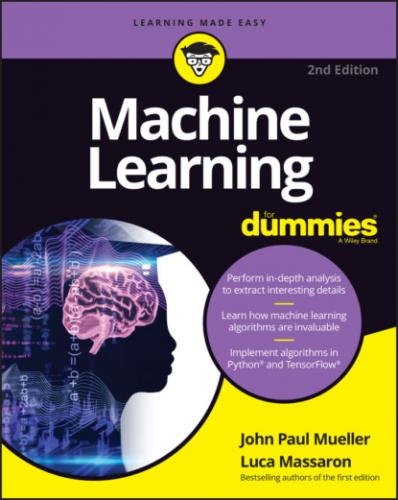https://www.computerworld.com/article/2990849/meet-the-virtual-woman-who-may-take-your-job.html). The reality is that you interact with AI and machine learning in far more mundane ways already. Part of the reason you need to read this chapter is to get past the hype and discover what AI can do for you today.
Machine learning and AI both have strong engineering components. That is, you can quantify both technologies precisely based on theory (substantiated and tested explanations) rather than simply hypothesis (a suggested explanation for a phenomenon). In addition, both have strong science components, through which people test concepts and create new ideas of how expressing the thought process might be possible. Finally, machine learning also has an artistic component, and this is where a talented scientist can excel. In some cases, AI and machine learning both seemingly defy logic, and only the true artist can make them work as expected.
YES, FULLY AUTONOMOUS WEAPONS EXIST
Before people send us their latest dissertations about fully autonomous weapons, yes, some benighted souls are working on such technologies. You’ll find some discussions of the ethics of AI in this book, but for the most part, the book focuses on positive, helpful uses of AI to aid humans, rather than kill them, because most AI research reflects these uses. You can find articles on the pros and cons of AI online, such as the Towards Data Science article at https://towardsdatascience.com/advantages-and-disadvantages-of-artificial-intelligence-182a5ef6588c and the Emerj article at https://emerj.com/ai-sector-overviews/autonomous-weapons-in-the-military/.
If you really must scare yourself, you can find all sorts of sites, such as https://www.reachingcriticalwill.org/resources/fact-sheets/critical-issues/7972-fully-autonomous-weapons, that discuss the issue of fully autonomous weapons in some depth. Sites such as Campaign to Stop Killer Robots (https://www.stopkillerrobots.org/) can also fill in some details for you. We do encourage you to sign the letter banning autonomous weapons at https://futureoflife.org/open-letter-autonomous-weapons/ — there truly is no need for them.
However, it’s important to remember that bans against space-based, chemical, and certain laser weapons all exist. Countries recognize that these weapons don’t solve anything. Countries will also likely ban fully autonomous weapons simply because the citizenry won’t stand for killer robots. The bottom line is that the focus of this book is on helping you understand machine learning in a positive light.
Dreaming of Electric Sheep
Androids (a specialized kind of robot that looks and acts like a human, such as Data in Star Trek: The Next Generation) and some types of humanoid robots (a kind of robot that has human characteristics but is easily distinguished from a human, such as C-3PO in Star Wars) have become the poster children for AI (see the dancing robots at https://www.youtube.com/watch?v=lTckiTBaWkw). They present computers in a form that people can anthropomorphize (give human characteristics to, even though they aren’t human). In fact, it’s entirely possible that one day you won’t be able to distinguish between human and artificial life with ease. Science fiction authors, such as Philip K. Dick, have long predicted such an occurrence, and it seems all too possible today. The story “Do Androids Dream of Electric Sheep?” discusses the whole concept of more real than real. The idea appears as part of the plot in the movie Blade Runner (https://www.warnerbros.com/movies/blade-runner). However, some uses of robots today are just plain fun, as in the Robot Restaurant show at https://www.youtube.com/watch?v=l1vvTtz8hpg. The sections that follow help you understand how close technology currently gets to the ideals presented by science fiction authors and the movies.
https://www.youtube.com/watch?v=LyyytwT-BMk and https://www.cnbc.com/2019/10/31/human-like-androids-have-entered-the-workplace-and-may-take-your-job.html. One of the more lifelike examples is Erica (https://www.youtube.com/watch?v=oRlwvLubFxg), who is set to appear in a science fiction film. Her story appears on HuffPost at https://www.huffpost.com/entry/erica-japanese-robot-science-fiction-film:n_5ef6523dc5b6acab284181c3. The point is, technology is just starting to get to the point where people may eventually be able to create lifelike robots and androids, but they don’t exist today.
Understanding the history of AI and machine learning
There is a reason, other than anthropomorphization, that humans see the ultimate AI as one that is contained within some type of android. Ever since the ancient Greeks, humans have discussed the possibility of placing a mind inside a mechanical body. One such myth is that of a mechanical man called Talos (http://www.ancient-wisdom.com/greekautomata.htm). The fact that the ancient Greeks had complex mechanical devices, only one of which still exists (read about the Antikythera mechanism at http://www.ancient-wisdom.com/antikythera.htm), makes it quite likely that their dreams were built on more than just fantasy. Throughout the centuries, people have discussed mechanical persons capable of thought (such as Rabbi Judah Loew's Golem, https://www.nytimes.com/2009/05/11/world/europe/11golem.html).
AI is built on the hypothesis that mechanizing thought is possible. During the first millennium, Greek, Indian, and Chinese philosophers all worked on ways to perform this task. As early as the seventeenth century, Gottfried Leibniz, Thomas Hobbes, and René Descartes discussed the potential for rationalizing all thought as simply math symbols. Of course, the complexity of the problem eluded them (and still eludes us today, despite the advances you read about in Part 3 of this book). The point is that the vision for AI has been around for an incredibly long time, but the implementation of AI is relatively new.
The true birth of AI as we know it today began with Alan Turing’s publication of “Computing Machinery
